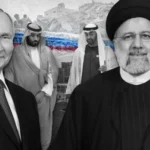Energy News Beat
MOSCOW – Last week, Russian President Vladimir Putin made a notable pit stop in the UAE and Saudi Arabia to meet, respectively, Emirati President Mohammad bin Zayed (MbZ) and Saudi Crown Prince Mohammad bin Salman (MbS) before flying back to Moscow to meet Iranian President Ebrahim Raisi.
The three key issues in all three meetings, confirmed by diplomatic sources, were Gaza, OPEC+, and BRICS expansion. They are, of course, interlinked.
The Russia-Iran strategic partnership is developing at breakneck speed, alongside Russia-Saudi Arabia (especially on OPEC+) and Russia-UAE (investments). This is already leading to stark shifts in defense interconnection across West Asia. The long-term implications for Israel, way beyond the Gaza tragedy, are stark.
Putin told Raisi something that was extraordinary on so many levels:
“When I was flying over Iran, I wanted to land in Tehran and to meet you. But I was informed that you wanted to visit Moscow. Relations between our countries are growing rapidly. Please convey my best wishes to the Supreme Leader, who supports our relations.”
Putin’s reference to “flying over Iran” directly connects with four armed Sukhoi Su-35s flying in formation, escorting the presidential plane over 4,000 km (if measured as a straight line) from Moscow to Abu Dhabi, without any landing or refueling.
As every stunned military analyst remarked, an American F-35 is capable of flying at best 2,500 km without refueling. Yet the most important element is that both MbZ and MbS authorized the Russian Su-35s escorts over their territory – which is something extremely unusual in diplomatic circles.
And that leads us to the key takeaway. With a single move on the aerial chessboard, compounded with the subsequent clincher with Raisi, Moscow accomplished four tasks:
Putin proved – graphically speaking – that this is a new West Asia where the US hegemon is a secondary actor; destroyed the neocon political myth of Russian “isolation;” demonstrated ample military supremacy; and lastly, as the start of Russia’s BRICS presidency approaches, showed that it retains all its crucial geopolitical and geoeconomic cards.
Kill them, but softly
The original five BRICS – led by the Russia-China strategic partnership – will open their doors to three major West Asian powers Iran, Saudi Arabia, and UAE on 1, January, 2024. Their accession to the multipolar powerhouse offers these countries an exceptional platform for broader markets, and is likely to accompany a flurry of investments and tech exchanges.
The long-term, sophisticated game played by Russia-China is leading to a complete, tectonic change in the geoeconomics and geopolitics of West Asia.
BRICS 10 leadership – considering that the 11th member, Argentina, for the moment, is a wild card at best – even has the potential, under a Russian presidency, to become an effective counterpart to the toothless UN.
And that leads us to the complex interaction between BRICS and the Axis of Resistance.
At first, there were reasons to suspect that the bland condemnation of the genocide in Gaza by the Arab League and the Organization of Islamic Cooperation (OIC) was a sign of cowardice.
Yet a renewed appraisal may reveal everything is evolving organically when it comes to the intersection of the Big Picture designed by the late Iranian Quds Force Commander General Qassem Soleimani with the meticulous micro-planning by Gaza’s Hamas leader Yahya Sinwar, who knows the Israeli mentality inside out and considered in detail its devastating military response.
Arguably, the most incandescent focus of detailed discussions in Moscow these past few days is that we may be approaching the point where “a signal” will unleash a concerted Axis of Resistance response.
For the moment, what we have are sporadic attacks: Hezbollah destroying Israel’s communication towers facing the southern Lebanon border, Iraq’s resistance forces attacking US bases in Iraq and Syria, and Yemen’s Ansarallah concretely blocking the Red Sea for Israeli ships. All that does not form a concerted, coordinated offensive – yet.
And that would explain the desperation within the Biden administration in Washington, complete with rumors that it needs Israel to finish Plan Gaza between Christmas and the start of January. Not only have the global optics of the Gaza assault become horrifyingly unsustainable, but most of all, a lengthier military campaign dramatically raises the likelihood of a “signal” to the Axis of Resistance.
And that will result in the end of all the Hegemon’s elaborate plans for West Asia.
The geopolitical goals of Zionism are quite clear: re-establish its self-constructed aura of dominance in West Asia and maintain steady control over US foreign policy and the military alliance.
Depravity is a key component for accomplishing these goals. It’s so easy to bomb, shell, and burn ultra-soft civilian targets, including thousands of women and children, turning Gaza into a vast cemetery, while the White Man’s Burden Club urges Israeli occupation forces to kill them, of course, but more silently.
Cue to toxic Atlanticist and European Commission President Ursula von der Leyen offering bribes, in person, to Egypt’s and Jordan’s leaders – $10 billion to Cairo and $5 billion to Amman – as confirmed with Brussels diplomats. That’s the mind-numbing EU solution to stopping the Gaza genocide.
All Egyptian President Abdel Fattah el-Sisi and Jordanian King Abdullah bin al-Hussein would need to do is to “facilitate” the forced exodus and Final Ethnic Cleansing of Gaza to their respective territories.
Because the eschatological goal of Zionism remains an undiluted Final Solution, whatever happens in the battleground. And, of course, as the 7 October Hamas-led Al-Aqsa Flood operation suggests, to destroy Jerusalem’s Islamic Al-Aqsa Mosque and build a Jewish Third Temple on top of its ashes.
What happens when “the signal” comes
So what we have is essentially Israeli Prime Minister Benjamin Netanyahu’s Emigration-or-Annihilation plan – versus what veteran West Asia expert Alastair Crooke has memorably coined as “Sykes-Picot is dead.” That phrase means that Arab and Iranian inclusion in BRICS will eventually rewrite the rules in West Asia, to the detriment of the Zionist project.
There’s even a strong possibility this time around that Israel’s certified war crimes in Gaza will be prosecuted, as Palestinians, Arabs, and Muslim-majority nations, with full BRICS support, form a Global South-recognized commission to take Tel Aviv and its armed forces to court.
Forget the tainted ICC, servile as it remains to the Hegemon’s Rules-Based Order. The BRICS will help usher international law back to the forefront of the global scene, as intended when the UN was born in 1945 before it was castrated.
The Gaza genocide is also forcing all latitudes along the Global South to be more inclusive – as in delving into the wisdom of our common, intertwined pre-modern history. Everyone with a conscience has been forced to dig deeply into oneself to find explanations for the Inexcusable. In this sense, we are all Palestinians now.
As it stands, no power – the west because it refuses it; the BRICS and the Global South because they have not yet made their play – has been capable of stopping a Final Solution conducted by a racist, ethnocentrist ideology.
Yet that also opens the startling possibility that no power will be strong enough to stop the Axis of Resistance when the “signal” comes to pull the curtain down on the Zionist Project. By that time, the Axis will have a supreme moral imperative, recognized, even urged, by populations globally.
So that’s where we are now: evaluating the incandescent symmetry between impotence and imperative. The deadlock will be broken – perhaps sooner than we all expect.
That evokes a comparison with a previous deadlock. The current impasse between a perverse, trashy version of Hebraic “civilization” and emerging Islamic nationalism – let’s call it “civilizational Islam” – mirrors where we were in December 2021, when Russian-proposed treaties on the “indivisibility of security” were turned down by Washington. In hindsight, that was the last chance for a peaceful way out of the clash between the Heartland and the Rimland.
The Hegemon rejected it. Russia made its play – and accelerated exponentially the decline of the Hegemon.
The song remains the same, from the steppes of Donbas to the oil fields of West Asia. How can the multipolar Global South – increasingly represented by the expanded BRICS – manage a raging, fearful, out-of-control imperialist west staring into the abyss of moral, political, and financial collapse?
ENB Top News
ENB
Energy Dashboard
ENB Podcast
ENB Substack
The post BRICS and the Resistance Axis: a convergence of goals appeared first on Energy News Beat.








